Step into the vibrant world of fruits with this captivating collection of 50 remarkable varieties, each beginning with the letter “R.” From tangy to sweet, these fruits come from diverse climates and cultures, bringing with them a burst of flavors, colors, and nutrients. This visual guide is perfect for those looking to expand their fruit knowledge, explore new tastes, or simply appreciate the beauty of nature’s bounty. Get ready to uncover the secrets, health benefits, and culinary uses of these “R” fruits, all brought to life with stunning images that showcase their natural allure.
1. Rambutan

| Category | Information |
|---|---|
| Flower Name | Rambutan Blossom |
| Scientific Name | Nephelium lappaceum |
| Nutritional Value | Per 100g: Calories – 68, Carbohydrates – 16.5g, Dietary Fiber – 0.9g, Sugars – 13.2g, Protein – 0.9g, Vitamin C – 8.3mg, Calcium – 22mg, Iron – 0.35mg, Magnesium – 7mg, Potassium – 42mg |
| Common Uses | Eaten fresh, in salads, desserts, jams, and as a topping for ice cream or yogurt. |
| Seasonality | June to August |
| Health Benefits | – Boosts immune system due to its vitamin C content. – Aids digestion with dietary fiber. – May improve iron absorption and promote healthy skin. |
| Interesting Fact | The name “rambutan” comes from the Malay word “rambut,” which means “hair,” referring to the hairy appearance of the fruit. |
2. Raisin
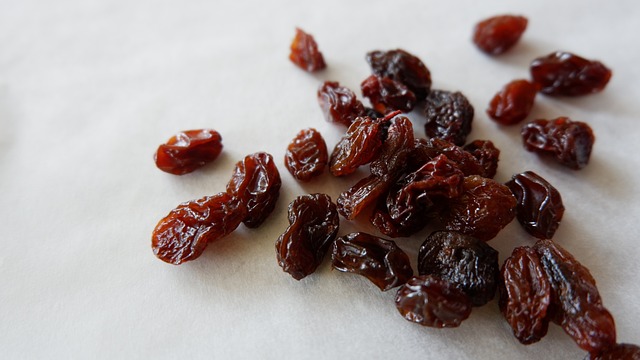
| Category | Information |
|---|---|
| Flower Name | Grapevine Flower |
| Scientific Name | Vitis vinifera |
| Nutritional Value | Per 100g: Calories – 299, Carbohydrates – 79.18g, Dietary Fiber – 3.7g, Sugars – 59.19g, Protein – 3.07g, Iron – 1.88mg, Potassium – 749mg, Vitamin C – 2.3mg, Calcium – 50mg |
| Common Uses | Snacking, in baked goods, cereals, salads, trail mixes, and cooking. |
| Seasonality | Available year-round (dried fruit) |
| Health Benefits | – Rich in fiber, promoting digestive health. – Contains antioxidants that help fight free radicals. – Provides quick energy and can help with anemia due to its iron content. |
| Interesting Fact | Raisins are dried grapes, and they can be made from several different types of grapes, including green, red, and purple varieties. |
3. Red Banana
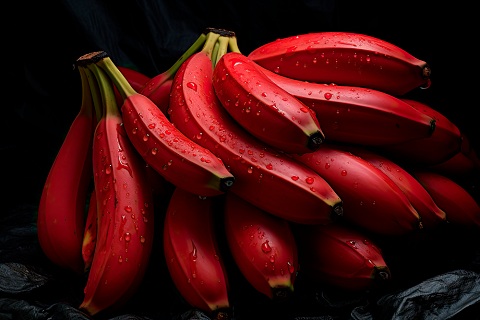
| Category | Information |
|---|---|
| Flower Name | Banana Flower (Inflorescence) |
| Scientific Name | Musa acuminata |
| Nutritional Value | Per 100g: Calories – 90, Carbohydrates – 23g, Dietary Fiber – 2.6g, Sugars – 12g, Protein – 1.1g, Vitamin C – 8.7mg, Potassium – 358mg, Vitamin B6 – 0.4mg, Magnesium – 27mg |
| Common Uses | Eaten fresh, in smoothies, desserts, baked goods, and salads. |
| Seasonality | Available year-round |
| Health Benefits | – Rich in potassium, supporting heart health and blood pressure regulation. – Good source of vitamin C and B6, promoting immune function and energy metabolism. – Aids digestion. |
| Interesting Fact | Red bananas are sweeter and creamier than yellow bananas, with a hint of raspberry flavor. |
4. Redcurrant
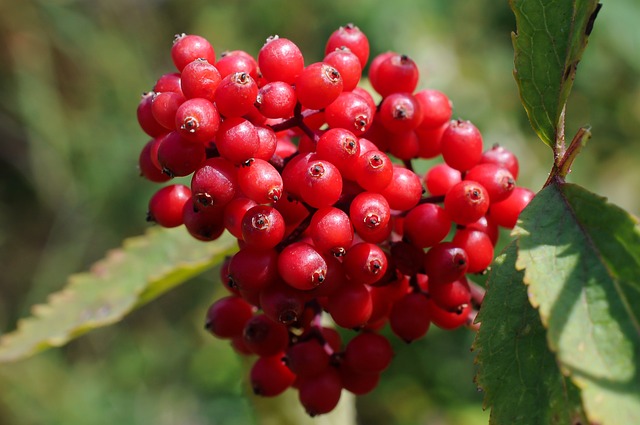
| Category | Information |
|---|---|
| Flower Name | Redcurrant Blossom |
| Scientific Name | Ribes rubrum |
| Nutritional Value | Per 100g: Calories – 56, Carbohydrates – 13.8g, Dietary Fiber – 4.3g, Sugars – 7.37g, Protein – 1.4g, Vitamin C – 41mg, Potassium – 275mg, Calcium – 33mg |
| Common Uses | Eaten fresh, in jams, jellies, sauces, desserts, and as a garnish. |
| Seasonality | Summer, primarily from June to August |
| Health Benefits | – High in vitamin C, supporting immune health. – Rich in antioxidants that protect against oxidative stress. – Contains fiber, aiding digestion and heart health. |
| Interesting Fact | Redcurrants have a tart flavor and are often used in traditional European recipes, including sauces for meats and desserts. |
5. Rose Apple
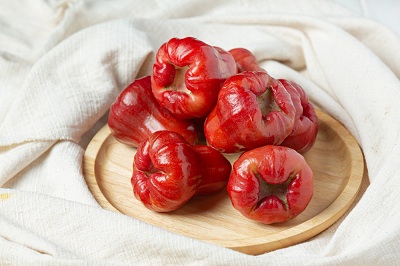
| Category | Information |
|---|---|
| Flower Name | Rose Apple Blossom |
| Scientific Name | Syzygium jambos |
| Nutritional Value | Per 100g: Calories – 25, Carbohydrates – 6g, Dietary Fiber – 1.5g, Sugars – 4g, Protein – 0.6g, Vitamin C – 22.3mg, Potassium – 123mg, Calcium – 29mg |
| Common Uses | Eaten fresh, in salads, jams, jellies, and desserts. |
| Seasonality | Summer to early fall |
| Health Benefits | – Low in calories, making it a healthy snack. – High in vitamin C, supporting immune function. – Contains fiber, which aids in digestion and heart health. |
| Interesting Fact | Despite the name, rose apples are not related to apples but are instead part of the myrtle family. They have a mild, sweet flavor reminiscent of roses. |
6. Rowan Berry

| Category | Information |
|---|---|
| Flower Name | Rowan Blossom |
| Scientific Name | Sorbus aucuparia |
| Nutritional Value | Per 100g: Calories – 100, Carbohydrates – 25g, Dietary Fiber – 5g, Sugars – 15g, Protein – 1.5g, Vitamin C – 98mg, Potassium – 300mg, Calcium – 50mg |
| Common Uses | Used in jams, jellies, wines, and as an ornamental plant. |
| Seasonality | Late summer to early winter |
| Health Benefits | – High in vitamin C, boosting immune function. – Contains antioxidants that may protect against chronic diseases. – Aids digestion and promotes heart health due to its fiber. |
| Interesting Fact | Rowan berries are often considered too bitter to eat raw, but they become more palatable after cooking or freezing, which reduces their bitterness. |
7. Red Mombin (Hog Plum)
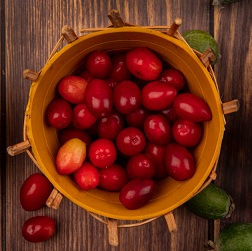
| Category | Information |
|---|---|
| Flower Name | Mombin Blossom |
| Scientific Name | Spondias purpurea |
| Nutritional Value | Per 100g: Calories – 48, Carbohydrates – 12g, Dietary Fiber – 1.4g, Sugars – 10g, Protein – 0.7g, Vitamin C – 11mg, Potassium – 70mg, Calcium – 11mg |
| Common Uses | Eaten fresh, in juices, jams, and sauces. |
| Seasonality | Summer to early fall |
| Health Benefits | – Rich in vitamin C, supporting immune health. – Provides antioxidants that help reduce inflammation. – Low in calories, making it a healthy, refreshing snack. |
| Interesting Fact | The red mombin is also known as “hog plum” because it was traditionally fed to pigs, though it is now appreciated for its tart, juicy flavor. |
8. Rockmelon (Cantaloupe)
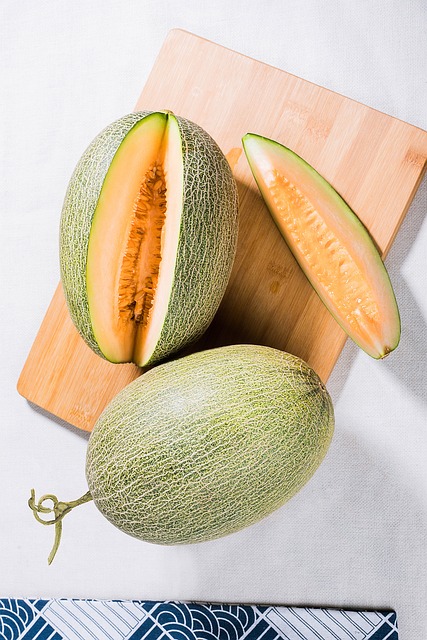
| Category | Information |
|---|---|
| Flower Name | Cantaloupe Blossom |
| Scientific Name | Cucumis melo var. cantalupensis |
| Nutritional Value | Per 100g: Calories – 34, Carbohydrates – 8.16g, Dietary Fiber – 0.9g, Sugars – 7.86g, Protein – 0.84g, Vitamin C – 36.7mg, Potassium – 267mg, Vitamin A – 3382 IU |
| Common Uses | Eaten fresh, in fruit salads, smoothies, desserts, and as a snack. |
| Seasonality | Summer, primarily from June to August |
| Health Benefits | – High in vitamin A, promoting healthy vision and skin. – Rich in vitamin C, supporting immune health. – Contains antioxidants that may help protect against chronic diseases. |
| Interesting Fact | Cantaloupe is sometimes called “rockmelon” in Australia and New Zealand due to its rough, netted rind. |
9. Red Grapes
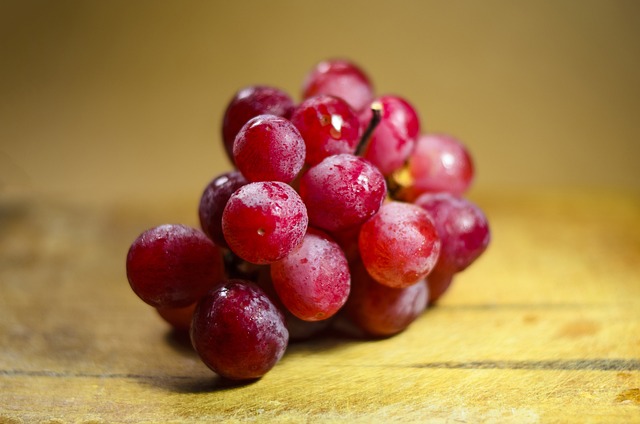
| Category | Information |
|---|---|
| Flower Name | Grapevine Flower |
| Scientific Name | Vitis vinifera |
| Nutritional Value | Per 100g: Calories – 69, Carbohydrates – 18.1g, Dietary Fiber – 0.9g, Sugars – 15.5g, Protein – 0.72g, Vitamin C – 10.8mg, Potassium – 191mg, Vitamin K – 14.6µg |
| Common Uses | Eaten fresh, in salads, desserts, juices, and wine production. |
| Seasonality | Late summer to early fall |
| Health Benefits | – Rich in antioxidants, including resveratrol, which supports heart health. – Provides vitamin K, important for bone health. – Hydrates the body due to high water content. |
| Interesting Fact | Red grapes are often used to produce red wine, which is thought to have heart-healthy benefits due to its polyphenol content. |
10. Rose Hip

| Category | Information |
|---|---|
| Flower Name | Wild Rose Blossom |
| Scientific Name | Rosa canina |
| Nutritional Value | Per 100g: Calories – 162, Carbohydrates – 38.22g, Dietary Fiber – 24.1g, Sugars – 2.58g, Protein – 1.6g, Vitamin C – 426mg, Vitamin A – 2176 IU, Calcium – 169mg, Iron – 1.03mg |
| Common Uses | Used in teas, jams, jellies, syrups, and as a supplement. |
| Seasonality | Late summer to early fall |
| Health Benefits | – Extremely high in vitamin C, supporting immune health. – Contains antioxidants that help fight inflammation. – May support skin health and reduce symptoms of arthritis. |
| Interesting Fact | Rose hips are the fruit of the wild rose and have been used for centuries in herbal medicine and skincare products. |
11. Rangpur Lime
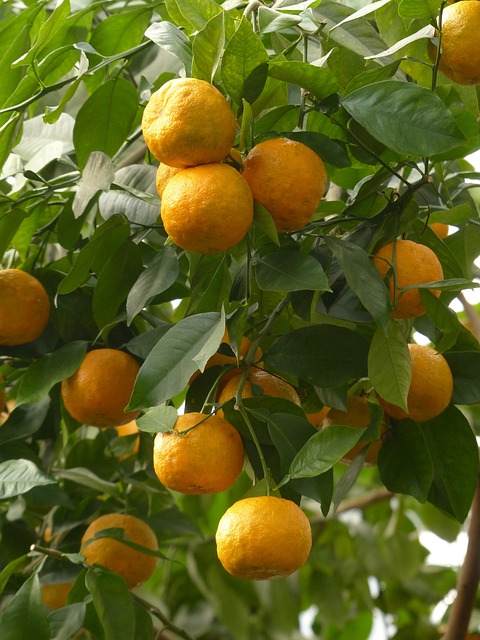
| Category | Information |
|---|---|
| Flower Name | Rangpur Lime Blossom |
| Scientific Name | Citrus × limonia |
| Nutritional Value | Per 100g: Calories – 30, Carbohydrates – 10.5g, Dietary Fiber – 2.8g, Sugars – 1.7g, Protein – 0.5g, Vitamin C – 29.1mg, Potassium – 166mg |
| Common Uses | Used in cooking, beverages, marmalades, and as a flavoring agent. |
| Seasonality | Late winter to early spring |
| Health Benefits | – High in vitamin C, boosting immune function. – Promotes digestion and may aid in weight management. – Contains antioxidants that help protect cells from damage. |
| Interesting Fact | Despite its name, the Rangpur lime is not a true lime but a hybrid between a mandarin orange and a lemon. |
12. Rumberry (Myrtle Berry)
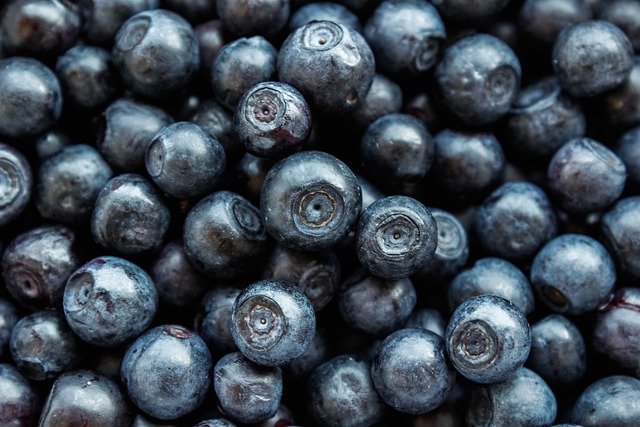
| Category | Information |
|---|---|
| Flower Name | Myrtle Blossom |
| Scientific Name | Myrciaria floribunda |
| Nutritional Value | Per 100g: Calories – 43, Carbohydrates – 11g, Dietary Fiber – 2.7g, Sugars – 7.6g, Protein – 0.5g, Vitamin C – 22mg, Potassium – 162mg, Calcium – 8mg |
| Common Uses | Eaten fresh, in jams, jellies, and beverages. |
| Seasonality | Late spring to early summer |
| Health Benefits | – Rich in vitamin C, supporting immune function. – Provides antioxidants that help protect against chronic diseases. – May aid in digestion and promote heart health. |
| Interesting Fact | Rumberries are known for their unique flavor, which is a mix of sweet and tart, often compared to a blend of cranberry and cherry. |
13. Red Huckleberry
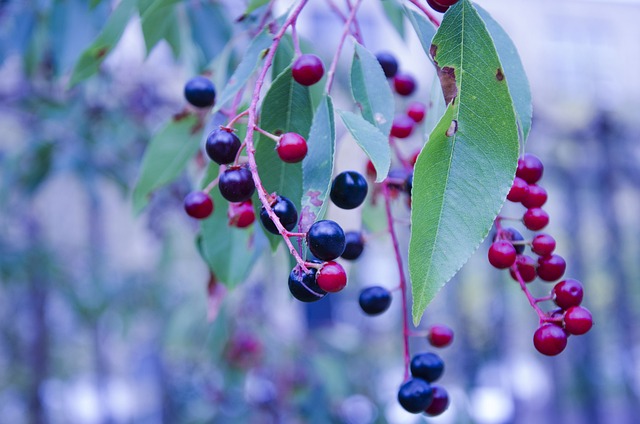
| Category | Information |
|---|---|
| Flower Name | Huckleberry Blossom |
| Scientific Name | Vaccinium parvifolium |
| Nutritional Value | Per 100g: Calories – 37, Carbohydrates – 9.1g, Dietary Fiber – 2.3g, Sugars – 6.2g, Protein – 0.4g, Vitamin C – 7mg, Potassium – 76mg, Calcium – 12mg |
| Common Uses | Eaten fresh, in jams, jellies, pies, and desserts. |
| Seasonality | Summer, primarily from July to September |
| Health Benefits | – High in antioxidants, supporting overall health. – Contains vitamin C, promoting immune function. – Low in calories, making it a healthy snack option. |
| Interesting Fact | Red huckleberries are native to the Pacific Northwest of the United States and were traditionally harvested by Native American tribes. |
14. Riberry (Lilly Pilly)
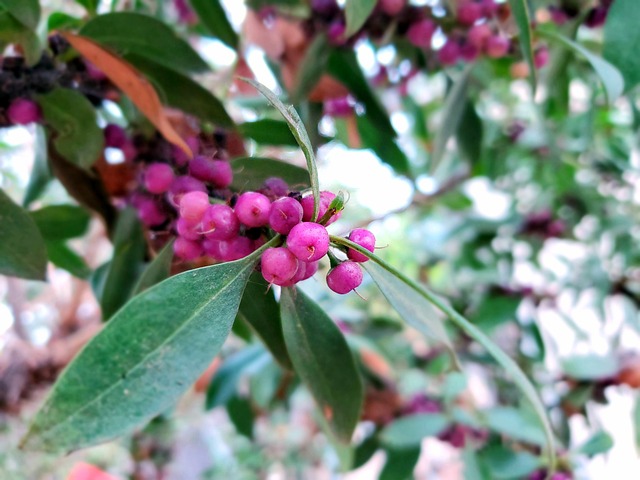
| Category | Information |
|---|---|
| Flower Name | Lilly Pilly Blossom |
| Scientific Name | Syzygium luehmannii |
| Nutritional Value | Per 100g: Calories – 45, Carbohydrates – 11g, Dietary Fiber – 2.5g, Sugars – 8g, Protein – 0.6g, Vitamin C – 14mg, Potassium – 115mg, Calcium – 16mg |
| Common Uses | Eaten fresh, in sauces, jams, jellies, and desserts. |
| Seasonality | Late summer to early fall |
| Health Benefits | – Rich in vitamin C, boosting immune health. – Contains antioxidants that help protect against oxidative stress. – Supports digestion and heart health due to its fiber content. |
| Interesting Fact | Riberries are native to Australia and have been used in Aboriginal cuisine for thousands of years, often called “bush food.” |
15. Red Mulberry
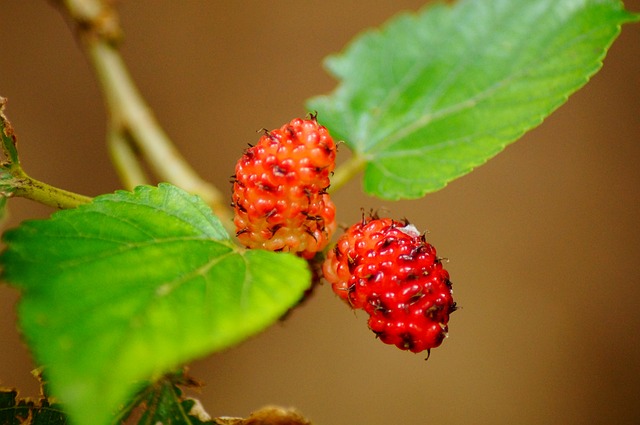
| Category | Information |
|---|---|
| Flower Name | Mulberry Blossom |
| Scientific Name | Morus rubra |
| Nutritional Value | Per 100g: Calories – 43, Carbohydrates – 9.8g, Dietary Fiber – 1.7g, Sugars – 8.1g, Protein – 1.4g, Vitamin C – 36.4mg, Potassium – 194mg, Calcium – 39mg |
| Common Uses | Eaten fresh, in jams, jellies, pies, and desserts. |
| Seasonality | Late spring to early summer |
| Health Benefits | – High in vitamin C, promoting immune health. – Rich in antioxidants that help reduce inflammation. – Supports digestion and heart health with its fiber content. |
| Interesting Fact | Red mulberries are native to North America and were an important food source for Native American tribes. |
16. Rollinia (Biriba)
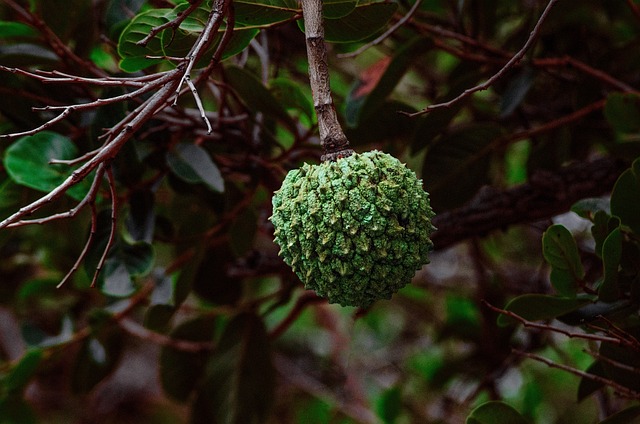
| Category | Information |
|---|---|
| Flower Name | Rollinia Blossom |
| Scientific Name | Rollinia mucosa |
| Nutritional Value | Per 100g: Calories – 80, Carbohydrates – 18.7g, Dietary Fiber – 1.9g, Sugars – 13.2g, Protein – 1.4g, Vitamin C – 22.6mg, Potassium – 382mg, Calcium – 17mg |
| Common Uses | Eaten fresh, in desserts, smoothies, and juices. |
| Seasonality | Late spring to early summer |
| Health Benefits | – High in vitamin C, supporting immune health. – Rich in potassium, promoting heart health. – Contains antioxidants that help protect against chronic diseases. |
| Interesting Fact | Rollinia is known for its custard-like texture and sweet, tropical flavor, often compared to a mix of banana, pineapple, and vanilla. |
17. Roselle (Hibiscus)

| Category | Information |
|---|---|
| Flower Name | Hibiscus Blossom |
| Scientific Name | Hibiscus sabdariffa |
| Nutritional Value | Per 100g: Calories – 37, Carbohydrates – 9.4g, Dietary Fiber – 0.3g, Sugars – 6.6g, Protein – 0.4g, Vitamin C – 12mg, Calcium – 215mg, Magnesium – 51mg |
| Common Uses | Used in teas, jams, jellies, sauces, and herbal remedies. |
| Seasonality | Late summer to early fall |
| Health Benefits | – High in antioxidants, supporting overall health. – May help lower blood pressure and cholesterol levels. – Contains vitamin C, promoting immune function. |
| Interesting Fact | The dried calyces of the Roselle plant are used to make hibiscus tea, which is popular worldwide for its tart flavor and potential health benefits. |
18. Red Bopple Nut
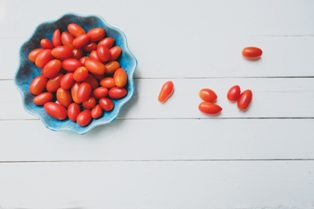
| Category | Information |
|---|---|
| Flower Name | Bopple Nut Blossom |
| Scientific Name | Hicksbeachia pinnatifolia |
| Nutritional Value | Per 100g: Calories – 210, Carbohydrates – 18g, Dietary Fiber – 3.2g, Sugars – 5.1g, Protein – 4.6g, Fats – 15g, Vitamin C – 9mg, Potassium – 120mg, Calcium – 32mg |
| Common Uses | Eaten fresh, in desserts, baked goods, and as a snack. |
| Seasonality | Late summer to early fall |
| Health Benefits | – Rich in healthy fats, supporting heart health. – Provides protein, important for muscle health. – Contains fiber, aiding digestion. |
| Interesting Fact | The red bopple nut is native to the rainforests of eastern Australia and is related to the macadamia nut. |
19. Red Bayberry
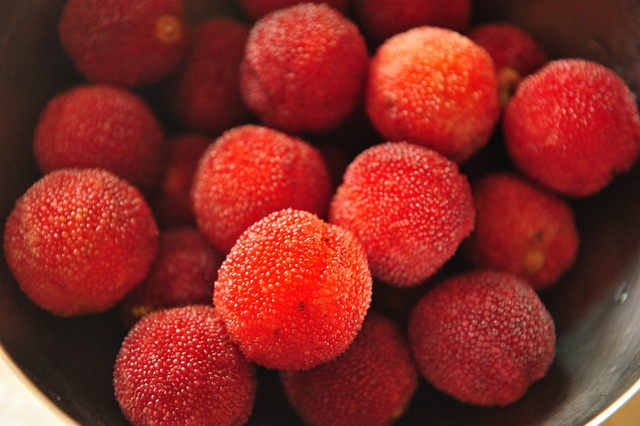
| Category | Information |
|---|---|
| Flower Name | Bayberry Blossom |
| Scientific Name | Myrica rubra |
| Nutritional Value | Per 100g: Calories – 54, Carbohydrates – 12.8g, Dietary Fiber – 1.9g, Sugars – 10.6g, Protein – 1.1g, Vitamin C – 53.3mg, Calcium – 20mg, Potassium – 156mg |
| Common Uses | Eaten fresh, in juices, wines, jams, and desserts. |
| Seasonality | Late spring to early summer |
| Health Benefits | – High in vitamin C, supporting immune health. – Contains antioxidants that help reduce inflammation. – Supports digestion and heart health with its fiber content. |
| Interesting Fact | Red bayberries are native to East Asia and have been cultivated for over 2,000 years in China, where they are highly valued for their tart-sweet flavor. |
20. Red Bush Apple
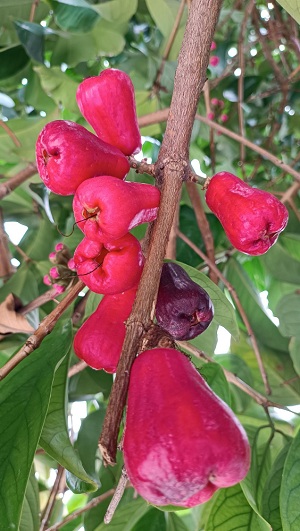
| Category | Information |
|---|---|
| Flower Name | Bush Apple Blossom |
| Scientific Name | Syzygium suborbiculare |
| Nutritional Value | Per 100g: Calories – 47, Carbohydrates – 12g, Dietary Fiber – 2.8g, Sugars – 9g, Protein – 0.7g, Vitamin C – 18mg, Potassium – 92mg, Calcium – 11mg |
| Common Uses | Eaten fresh, in jams, jellies, and desserts. |
| Seasonality | Late summer to early fall |
| Health Benefits | – Rich in vitamin C, boosting immune health. – Provides antioxidants that help protect against oxidative stress. – Supports digestion and heart health due to its fiber content. |
| Interesting Fact | The red bush apple is native to northern Australia and is an important food source for Indigenous Australians, often eaten fresh or dried. |
21. Red Dragon Fruit
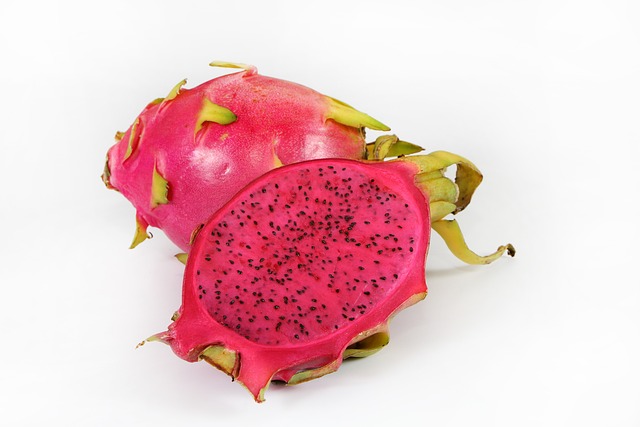
| Category | Information |
|---|---|
| Flower Name | Dragon Fruit Blossom |
| Scientific Name | Hylocereus costaricensis |
| Nutritional Value | Per 100g: Calories – 50, Carbohydrates – 11g, Dietary Fiber – 3g, Sugars – 8g, Protein – 1.2g, Vitamin C – 3mg, Calcium – 18mg, Iron – 1.8mg |
| Common Uses | Eaten fresh, in smoothies, desserts, salads, and juices. |
| Seasonality | Summer to early fall |
| Health Benefits | – Rich in fiber, promoting digestion and heart health. – Contains antioxidants that help fight free radicals. – Provides vitamin C, supporting immune function. |
| Interesting Fact | The vibrant red flesh of the red dragon fruit is due to the presence of betalains, which are powerful antioxidants. |
22. Red Guava
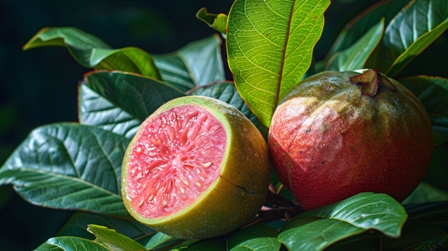
| Category | Information |
|---|---|
| Flower Name | Guava Blossom |
| Scientific Name | Psidium guajava |
| Nutritional Value | Per 100g: Calories – 68, Carbohydrates – 14.32g, Dietary Fiber – 5.4g, Sugars – 8.92g, Protein – 2.55g, Vitamin C – 228.3mg, Potassium – 417mg, Calcium – 18mg |
| Common Uses | Eaten fresh, in juices, smoothies, jams, and desserts. |
| Seasonality | Summer to early fall |
| Health Benefits | – Extremely high in vitamin C, boosting immune health. – Contains fiber, aiding digestion and heart health. – Rich in antioxidants, helping protect against chronic diseases. |
| Interesting Fact | Red guavas are known for their sweet flavor and are often used in tropical fruit salads and juices. |
23. Red Kiwi
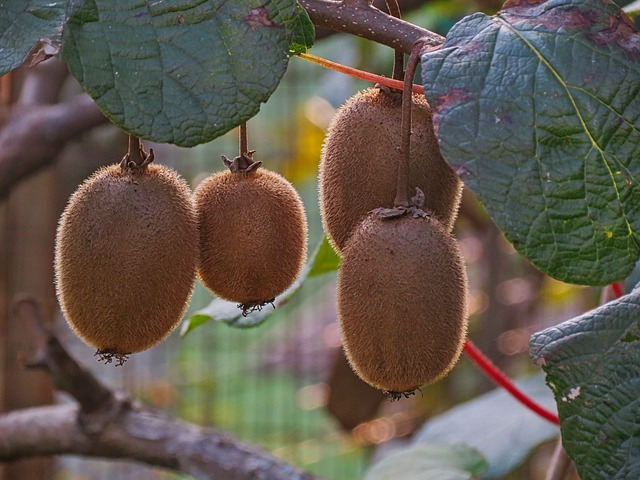
| Category | Information |
|---|---|
| Flower Name | Kiwi Blossom |
| Scientific Name | Actinidia chinensis var. chinensis |
| Nutritional Value | Per 100g: Calories – 61, Carbohydrates – 14.66g, Dietary Fiber – 3g, Sugars – 9g, Protein – 1.14g, Vitamin C – 92.7mg, Potassium – 312mg, Calcium – 34mg |
| Common Uses | Eaten fresh, in salads, smoothies, desserts, and as a garnish. |
| Seasonality | Late winter to early summer |
| Health Benefits | – High in vitamin C, promoting immune function. – Rich in fiber, aiding digestion and heart health. – Contains antioxidants that help protect cells from damage. |
| Interesting Fact | Red kiwis have a unique, sweet flavor with hints of berry, and their red color comes from natural pigments called anthocyanins. |
24. Red Orange (Blood Orange)
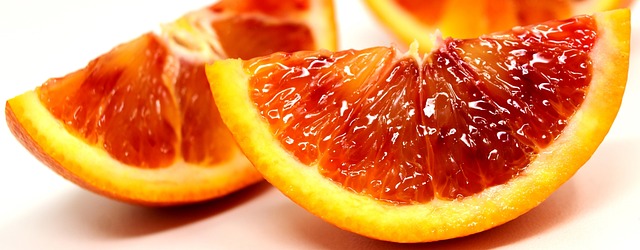
| Category | Information |
|---|---|
| Flower Name | Orange Blossom |
| Scientific Name | Citrus × sinensis |
| Nutritional Value | Per 100g: Calories – 47, Carbohydrates – 11.75g, Dietary Fiber – 2.4g, Sugars – 9g, Protein – 0.94g, Vitamin C – 53.2mg, Potassium – 181mg, Calcium – 40mg |
| Common Uses | Eaten fresh, in juices, salads, desserts, and as a garnish. |
| Seasonality | Winter to early spring |
| Health Benefits | – Rich in vitamin C, supporting immune health. – Contains antioxidants, including anthocyanins, which help fight inflammation. – May support heart health and healthy skin. |
| Interesting Fact | The red color of blood oranges is due to the presence of anthocyanins, which develop in response to colder temperatures during growth. |
25. Red Pear
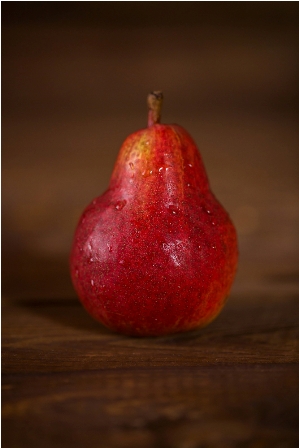
| Category | Information |
|---|---|
| Flower Name | Pear Blossom |
| Scientific Name | Pyrus communis |
| Nutritional Value | Per 100g: Calories – 57, Carbohydrates – 15g, Dietary Fiber – 3.1g, Sugars – 9.8g, Protein – 0.36g, Vitamin C – 4.3mg, Potassium – 116mg, Calcium – 9mg |
| Common Uses | Eaten fresh, in salads, desserts, and as a snack. |
| Seasonality | Late summer to early fall |
| Health Benefits | – Rich in fiber, promoting digestion and heart health. – Contains vitamin C, supporting immune function. – Provides antioxidants that help reduce inflammation. |
| Interesting Fact | Red pears are known for their vibrant color, which comes from natural pigments called anthocyanins, and their sweet, juicy flavor. |
26. Red Chokeberry
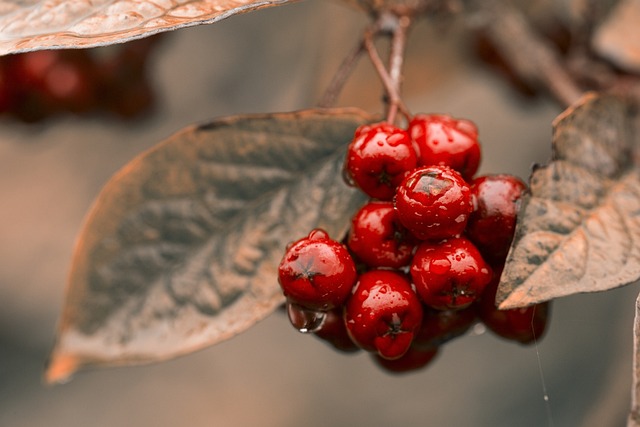
| Category | Information |
|---|---|
| Flower Name | Chokeberry Blossom |
| Scientific Name | Aronia arbutifolia |
| Nutritional Value | Per 100g: Calories – 47, Carbohydrates – 9.6g, Dietary Fiber – 5.3g, Sugars – 4.8g, Protein – 1.4g, Vitamin C – 21mg, Potassium – 156mg, Calcium – 25mg |
| Common Uses | Used in juices, jams, jellies, and as a garnish. |
| Seasonality | Fall, primarily from September to November |
| Health Benefits | – Extremely high in antioxidants, supporting overall health. – Contains vitamin C, boosting immune function. – Provides fiber, aiding digestion and heart health. |
| Interesting Fact | Red chokeberries are known for their astringent taste, which makes them more commonly used in processed products like juices and jams rather than eaten fresh. |
27. Red Raspberry
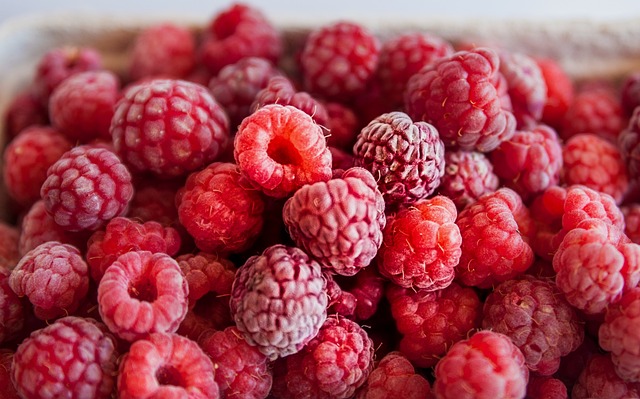
| Category | Information |
|---|---|
| Flower Name | Raspberry Blossom |
| Scientific Name | Rubus idaeus |
| Nutritional Value | Per 100g: Calories – 52, Carbohydrates – 11.9g, Dietary Fiber – 6.5g, Sugars – 4.4g, Protein – 1.2g, Vitamin C – 26.2mg, Potassium – 151mg, Calcium – 25mg |
| Common Uses | Eaten fresh, in desserts, jams, jellies, and as a garnish. |
| Seasonality | Summer, primarily from June to August |
| Health Benefits | – High in fiber, promoting digestion and heart health. – Contains antioxidants, including vitamin C, which support immune function. – May help reduce inflammation and aging. |
| Interesting Fact | Red raspberries have been enjoyed since ancient times, with records of their use dating back to prehistoric times in Europe. |
28. Red Plum
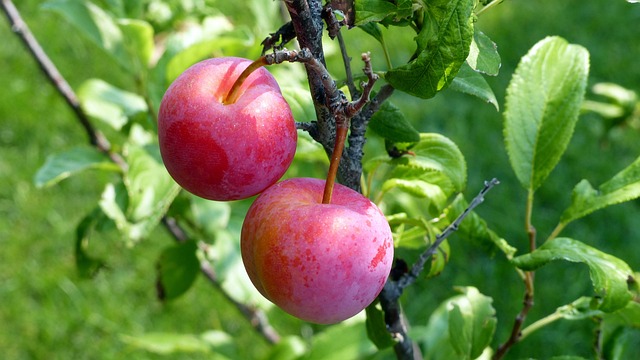
| Category | Information |
|---|---|
| Flower Name | Plum Blossom |
| Scientific Name | Prunus domestica |
| Nutritional Value | Per 100g: Calories – 46, Carbohydrates – 11.4g, Dietary Fiber – 1.4g, Sugars – 9.6g, Protein – 0.7g, Vitamin C – 9.5mg, Potassium – 157mg, Calcium – 6mg |
| Common Uses | Eaten fresh, in desserts, jams, jellies, and sauces. |
| Seasonality | Summer, primarily from June to September |
| Health Benefits | – Rich in vitamin C, supporting immune health. – Contains antioxidants that help reduce inflammation. – Promotes digestion with its fiber content. |
| Interesting Fact | Red plums are a hybrid fruit, with some varieties resulting from the crossbreeding of Japanese and European plums. |
29. Red Mombin
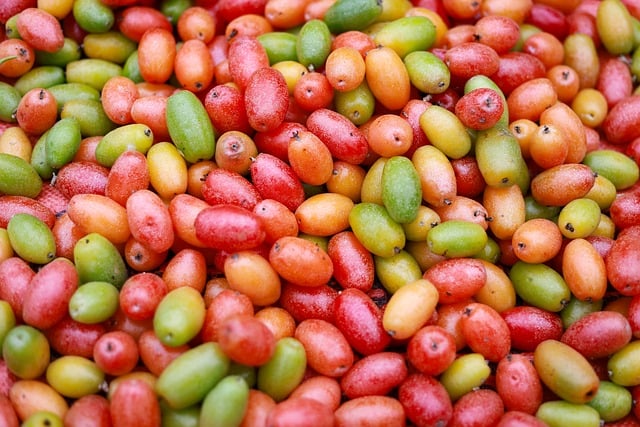
| Category | Information |
|---|---|
| Flower Name | Mombin Blossom |
| Scientific Name | Spondias purpurea |
| Nutritional Value | Per 100g: Calories – 67, Carbohydrates – 17g, Dietary Fiber – 2.8g, Sugars – 14g, Protein – 0.6g, Vitamin C – 32.3mg, Potassium – 193mg, Calcium – 11mg |
| Common Uses | Eaten fresh, in juices, jams, and desserts. |
| Seasonality | Late summer to early fall |
| Health Benefits | – High in vitamin C, boosting immune health. – Rich in antioxidants, supporting overall health. – Promotes digestion and heart health with its fiber content. |
| Interesting Fact | Red mombins are native to tropical regions of the Americas and are sometimes called “hog plums” due to their popularity as animal fodder. |
30. Rosy Apple
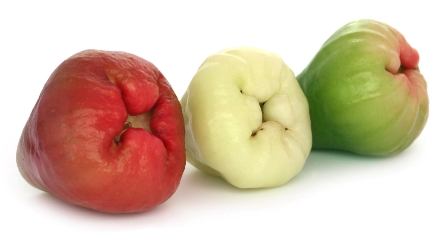
| Category | Information |
|---|---|
| Flower Name | Apple Blossom |
| Scientific Name | Malus pumila |
| Nutritional Value | Per 100g: Calories – 52, Carbohydrates – 13.8g, Dietary Fiber – 2.4g, Sugars – 10.4g, Protein – 0.3g, Vitamin C – 4.6mg, Potassium – 107mg, Calcium – 6mg |
| Common Uses | Eaten fresh, in desserts, salads, and as a snack. |
| Seasonality | Fall, primarily from September to November |
| Health Benefits | – Rich in fiber, promoting digestion and heart health. – Contains vitamin C, supporting immune function. – Provides antioxidants that help protect cells from damage. |
| Interesting Fact | Rosy apples get their name from their rosy-red color and sweet flavor, which make them a popular choice for eating fresh. |
31. Red Bignay
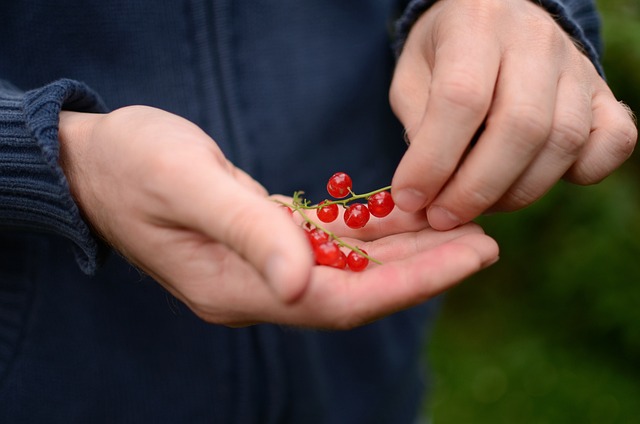
| Category | Information |
|---|---|
| Flower Name | Bignay Blossom |
| Scientific Name | Antidesma bunius |
| Nutritional Value | Per 100g: Calories – 67, Carbohydrates – 16g, Dietary Fiber – 3.8g, Sugars – 10g, Protein – 1g, Vitamin C – 20mg, Potassium – 100mg, Calcium – 15mg |
| Common Uses | Eaten fresh, in juices, jams, and fermented into wine. |
| Seasonality | Summer, primarily from June to August |
| Health Benefits | – High in antioxidants, promoting overall health. – Contains vitamin C, boosting immune function. – Provides fiber, aiding digestion. |
| Interesting Fact | Red bignay is often called “wild cherry” in Southeast Asia and is known for its tart flavor, often used in making a unique, slightly sour wine. |
32. Red Fleshed Pitaya
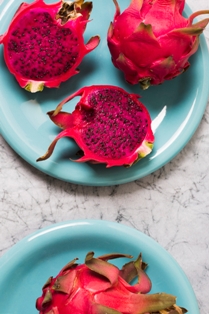
| Category | Information |
|---|---|
| Flower Name | Pitaya Blossom |
| Scientific Name | Hylocereus costaricensis |
| Nutritional Value | Per 100g: Calories – 50, Carbohydrates – 11g, Dietary Fiber – 3g, Sugars – 8g, Protein – 1.1g, Vitamin C – 3mg, Potassium – 116mg, Calcium – 9mg |
| Common Uses | Eaten fresh, in smoothies, salads, and desserts. |
| Seasonality | Summer, primarily from June to September |
| Health Benefits | – High in antioxidants, supporting overall health. – Contains vitamin C, boosting immune function. – Provides fiber, promoting digestion and heart health. |
| Interesting Fact | Red fleshed pitaya, or red dragon fruit, is known for its vibrant red flesh and sweet flavor, often enjoyed for its unique appearance and nutritional benefits. |
33. Red Anjou Pear
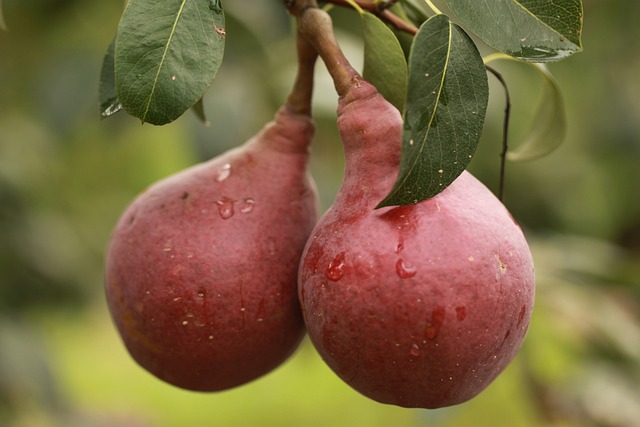
| Category | Information |
|---|---|
| Flower Name | Pear Blossom |
| Scientific Name | Pyrus communis |
| Nutritional Value | Per 100g: Calories – 57, Carbohydrates – 15g, Dietary Fiber – 3.1g, Sugars – 9.8g, Protein – 0.36g, Vitamin C – 4.3mg, Potassium – 116mg, Calcium – 9mg |
| Common Uses | Eaten fresh, in salads, desserts, and as a snack. |
| Seasonality | Late summer to early fall |
| Health Benefits | – Rich in fiber, promoting digestion and heart health. – Contains vitamin C, supporting immune function. – Provides antioxidants that help reduce inflammation. |
| Interesting Fact | Red Anjou pears have a beautiful red skin and a sweet, juicy flavor, making them a popular choice for fresh eating and culinary use. |
34. Red Watermelon
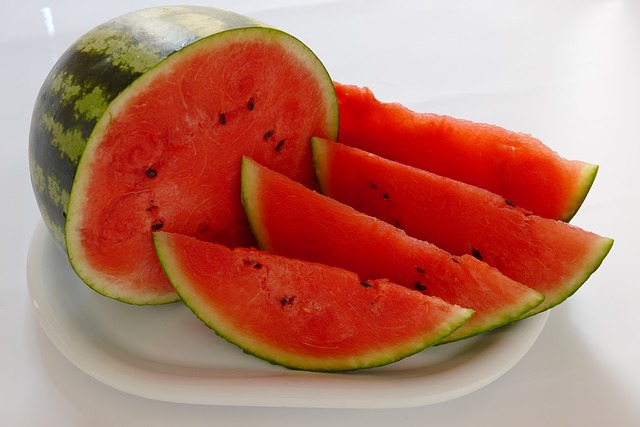
| Category | Information |
|---|---|
| Flower Name | Watermelon Blossom |
| Scientific Name | Citrullus lanatus |
| Nutritional Value | Per 100g: Calories – 30, Carbohydrates – 7.6g, Dietary Fiber – 0.4g, Sugars – 6.2g, Protein – 0.6g, Vitamin C – 8.1mg, Potassium – 112mg, Calcium – 7mg |
| Common Uses | Eaten fresh, in salads, smoothies, and as a refreshing snack. |
| Seasonality | Summer, primarily from June to August |
| Health Benefits | – Hydrating, due to its high water content. – Rich in vitamin C, supporting immune function. – Contains antioxidants, such as lycopene, which may help protect against diseases. |
| Interesting Fact | Red watermelons are a summer favorite, known for their refreshing sweetness and high water content, making them a popular choice for staying hydrated in hot weather. |
35. Red Mango
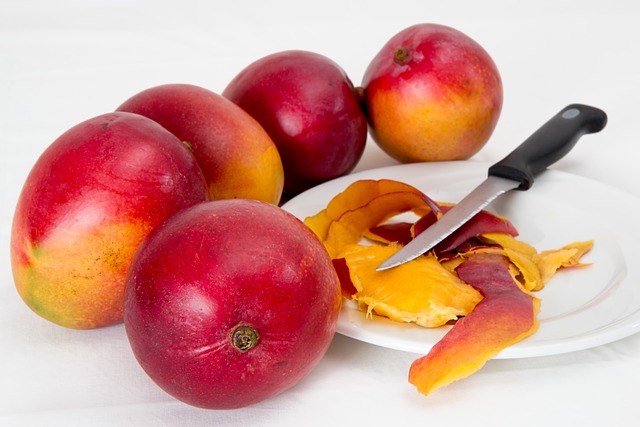
| Category | Information |
|---|---|
| Flower Name | Mango Blossom |
| Scientific Name | Mangifera indica |
| Nutritional Value | Per 100g: Calories – 60, Carbohydrates – 15g, Dietary Fiber – 1.6g, Sugars – 13.7g, Protein – 0.8g, Vitamin C – 36.4mg, Potassium – 168mg, Calcium – 11mg |
| Common Uses | Eaten fresh, in smoothies, salads, desserts, and as a garnish. |
| Seasonality | Summer, primarily from May to September |
| Health Benefits | – High in vitamin C, supporting immune health. – Contains fiber, aiding digestion and heart health. – Rich in antioxidants, supporting overall health. |
| Interesting Fact | Red mangoes are known for their sweet and tangy flavor, making them a popular choice for both fresh eating and culinary use. |
36. Red Delicious Apple
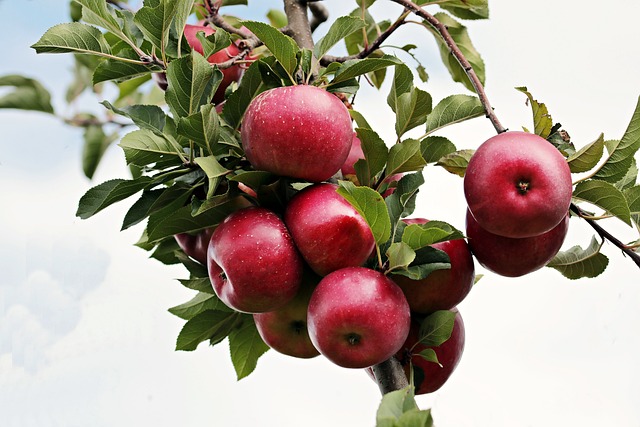
| Category | Information |
|---|---|
| Flower Name | Apple Blossom |
| Scientific Name | Malus domestica |
| Nutritional Value | Per 100g: Calories – 52, Carbohydrates – 13.8g, Dietary Fiber – 2.4g, Sugars – 10.4g, Protein – 0.3g, Vitamin C – 4.6mg, Potassium – 107mg, Calcium – 6mg |
| Common Uses | Eaten fresh, in salads, desserts, and as a snack. |
| Seasonality | Fall, primarily from September to November |
| Health Benefits | – Rich in fiber, promoting digestion and heart health. – Contains vitamin C, supporting immune function. – Provides antioxidants that help protect cells from damage. |
| Interesting Fact | Red Delicious apples are one of the most widely grown apple varieties in the United States, known for their bright red color and sweet flavor. |
37. Red Malabar Spinach Berry
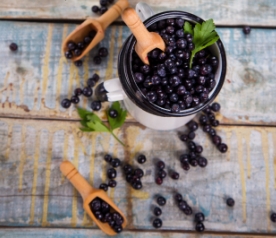
| Category | Information |
|---|---|
| Flower Name | Malabar Spinach Blossom |
| Scientific Name | Basella alba |
| Nutritional Value | Per 100g: Calories – 19, Carbohydrates – 3.4g, Dietary Fiber – 1.8g, Sugars – 0.4g, Protein – 1.8g, Vitamin C – 102mg, Potassium – 510mg, Calcium – 109mg |
| Common Uses | Eaten fresh, in salads, or cooked in soups and stews. |
| Seasonality | Summer and fall, primarily from June to October |
| Health Benefits | – Rich in vitamin C, supporting immune function. – Contains iron and calcium, promoting bone health. – Provides antioxidants, supporting overall health. |
| Interesting Fact | The red Malabar spinach berry is often used as a natural food coloring due to its deep red-purple hue, and it’s also consumed for its slightly sweet taste. |
38. Red Pawpaw
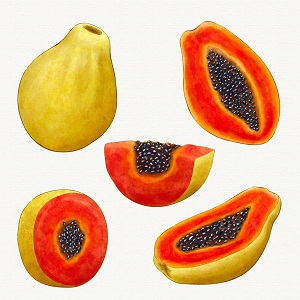
| Category | Information |
|---|---|
| Flower Name | Pawpaw Blossom |
| Scientific Name | Asimina triloba |
| Nutritional Value | Per 100g: Calories – 80, Carbohydrates – 18.8g, Dietary Fiber – 2.6g, Sugars – 12.3g, Protein – 1.2g, Vitamin C – 18mg, Potassium – 345mg, Calcium – 21mg |
| Common Uses | Eaten fresh, in desserts, smoothies, and as a snack. |
| Seasonality | Fall, primarily from September to October |
| Health Benefits | – Rich in vitamins C and A, supporting immune and skin health. – Contains antioxidants, promoting overall health. – Provides fiber, aiding digestion. |
| Interesting Fact | The red pawpaw, also known as “American custard apple,” is the largest edible fruit native to the United States and has a flavor often described as a mix between banana and mango. |
39. Red Mamey Sapote
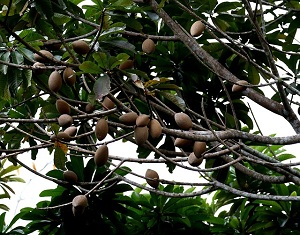
| Category | Information |
|---|---|
| Flower Name | Mamey Blossom |
| Scientific Name | Pouteria sapota |
| Nutritional Value | Per 100g: Calories – 124, Carbohydrates – 32g, Dietary Fiber – 5g, Sugars – 19g, Protein – 2g, Vitamin C – 23mg, Potassium – 454mg, Calcium – 14mg |
| Common Uses | Eaten fresh, in smoothies, ice creams, and desserts. |
| Seasonality | Spring to early summer, primarily from March to June |
| Health Benefits | – High in vitamin C, supporting immune function. – Contains potassium, promoting heart health. – Provides dietary fiber, aiding digestion. |
| Interesting Fact | The red Mamey sapote is a tropical fruit native to Central America, known for its creamy texture and sweet flavor, often compared to pumpkin pie. |
40. Red Elderberry
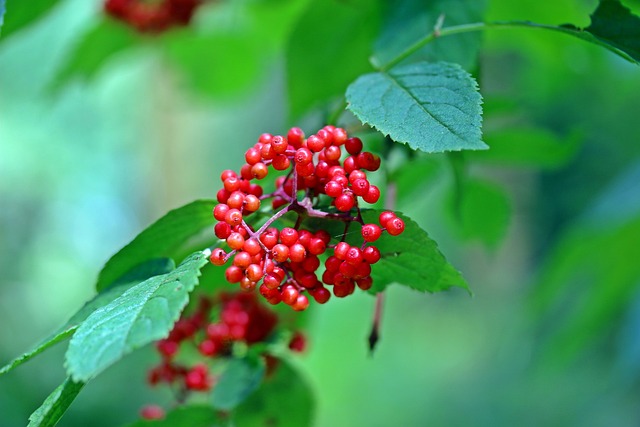
| Category | Information |
|---|---|
| Flower Name | Elderberry Blossom |
| Scientific Name | Sambucus racemosa |
| Nutritional Value | Per 100g: Calories – 73, Carbohydrates – 18.4g, Dietary Fiber – 7g, Sugars – 11g, Protein – 0.7g, Vitamin C – 36mg, Potassium – 280mg, Calcium – 38mg |
| Common Uses | Used in jams, jellies, syrups, and wines. |
| Seasonality | Late summer to early fall |
| Health Benefits | – High in antioxidants, supporting overall health. – Contains vitamin C, boosting immune function. – Provides dietary fiber, aiding digestion and heart health. |
| Interesting Fact | Red elderberries are less commonly consumed fresh due to their tartness and slight toxicity when raw, but are popular in processed forms like syrups and wines. |
67. Red Nance

| Category | Information |
|---|---|
| Flower Name | Nance Blossom |
| Scientific Name | Byrsonima crassifolia |
| Nutritional Value | Per 100g: Calories – 68, Carbohydrates – 15.8g, Dietary Fiber – 1.2g, Sugars – 14g, Protein – 0.4g, Vitamin C – 22mg, Potassium – 130mg, Calcium – 12mg |
| Common Uses | Eaten fresh, in juices, jams, and desserts. |
| Seasonality | Summer, primarily from June to August |
| Health Benefits | – High in vitamin C, supporting immune function. – Contains antioxidants, promoting skin health. – Provides fiber, aiding digestion. |
| Interesting Fact | Red Nance is a small, tropical fruit that has a strong, pungent aroma and flavor, often used in traditional desserts and beverages in Central and South America. |
42. Raw Navel Orange

| Category | Information |
|---|---|
| Flower Name | Orange Blossom |
| Scientific Name | Citrus sinensis |
| Nutritional Value | Per 100g: Calories – 47, Carbohydrates – 11.8g, Dietary Fiber – 2.4g, Sugars – 9g, Protein – 0.9g, Vitamin C – 53.2mg, Potassium – 181mg, Calcium – 40mg |
| Common Uses | Eaten fresh, in juices, salads, and desserts. |
| Seasonality | Winter, primarily from December to February |
| Health Benefits | – Extremely high in vitamin C, supporting immune health. – Rich in fiber, promoting digestion and heart health. – Contains antioxidants that help protect against chronic diseases. |
| Interesting Fact | Red navel oranges, also known as Cara Cara oranges, have a unique pinkish-red flesh and a sweet, less acidic flavor compared to regular oranges. |
43. Red Butia Palm Fruit

| Category | Information |
|---|---|
| Flower Name | Butia Palm Blossom |
| Scientific Name | Butia capitata |
| Nutritional Value | Per 100g: Calories – 53, Carbohydrates – 13.5g, Dietary Fiber – 2.1g, Sugars – 10g, Protein – 0.6g, Vitamin C – 35mg, Potassium – 186mg, Calcium – 20mg |
| Common Uses | Eaten fresh, in jams, jellies, and fermented into beverages. |
| Seasonality | Late summer to early fall |
| Health Benefits | – High in vitamin C, supporting immune function. – Contains antioxidants, promoting overall health. – Provides fiber, aiding digestion. |
| Interesting Fact | The red Butia palm fruit, also known as “jelly palm fruit,” is often used to make a sweet, tangy jelly and is a traditional delicacy in South America. |
44. Red Star Apple
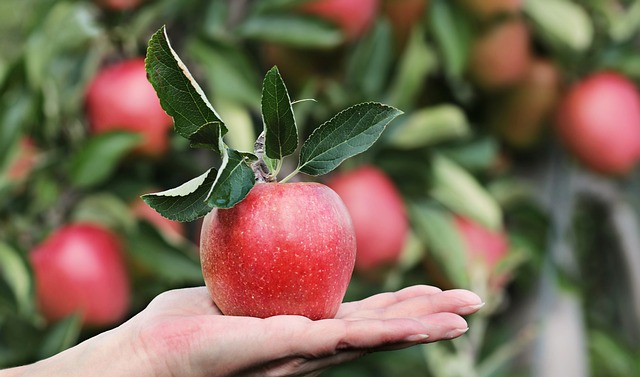
| Category | Information |
|---|---|
| Flower Name | Star Apple Blossom |
| Scientific Name | Chrysophyllum cainito |
| Nutritional Value | Per 100g: Calories – 67, Carbohydrates – 15g, Dietary Fiber – 3.3g, Sugars – 10g, Protein – 0.8g, Vitamin C – 3mg, Potassium – 133mg, Calcium – 17mg |
| Common Uses | Eaten fresh, in desserts, smoothies, and jams. |
| Seasonality | Winter to early spring, primarily from December to April |
| Health Benefits | – Contains fiber, aiding digestion and heart health. – Rich in antioxidants, supporting overall health. – Provides vitamin C, supporting immune function. |
| Interesting Fact | Red star apples have a unique star-shaped pattern when sliced open, and their sweet, milky flesh is a popular treat in tropical regions. |
45. Red Jaboticaba

| Category | Information |
|---|---|
| Flower Name | Jaboticaba Blossom |
| Scientific Name | Plinia cauliflora |
| Nutritional Value | Per 100g: Calories – 50, Carbohydrates – 13g, Dietary Fiber – 0.6g, Sugars – 12g, Protein – 0.3g, Vitamin C – 22mg, Potassium – 85mg, Calcium – 6mg |
| Common Uses | Eaten fresh, in jellies, wines, and desserts. |
| Seasonality | Spring and fall, primarily from March to May and August to October |
| Health Benefits | – High in vitamin C, boosting immune function. – Contains antioxidants, supporting overall health. – Provides fiber, aiding digestion. |
| Interesting Fact | Red jaboticaba is unique in that the fruit grows directly on the trunk and branches of the tree, giving it a distinctive appearance. |
46. Red Muntingia (Jamaica Cherry)
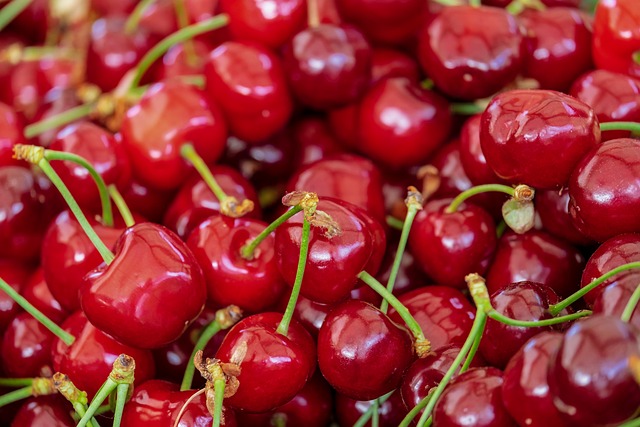
| Category | Information |
|---|---|
| Flower Name | Muntingia Blossom |
| Scientific Name | Muntingia calabura |
| Nutritional Value | Per 100g: Calories – 79, Carbohydrates – 20g, Dietary Fiber – 1.5g, Sugars – 15g, Protein – 1.4g, Vitamin C – 45mg, Potassium – 124mg, Calcium – 19mg |
| Common Uses | Eaten fresh, in jams, jellies, and as a snack. |
| Seasonality | Year-round, with peak season in late summer and fall |
| Health Benefits | – High in vitamin C, supporting immune function. – Contains antioxidants, promoting overall health. – Provides fiber, aiding digestion. |
| Interesting Fact | Red Muntingia, also known as Jamaica cherry, produces small, sweet berries that are popular in tropical regions and often used in traditional medicine. |
47. Red Tamarillo
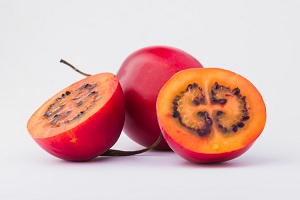
| Category | Information |
|---|---|
| Flower Name | Tamarillo Blossom |
| Scientific Name | Solanum betaceum |
| Nutritional Value | Per 100g: Calories – 31, Carbohydrates – 7.3g, Dietary Fiber – 1.5g, Sugars – 4.3g, Protein – 1.9g, Vitamin C – 17.3mg, Potassium – 321mg, Calcium – 12mg |
| Common Uses | Eaten fresh, in salads, sauces, and jams. |
| Seasonality | Winter, primarily from May to September |
| Health Benefits | – High in vitamin C, supporting immune function. – Rich in potassium, which is important for heart health. – Provides antioxidants, supporting overall health. |
| Interesting Fact | Red tamarillos, also known as “tree tomatoes,” have a tangy, slightly sweet flavor, making them a unique addition to various dishes. |
48. Red Passion Fruit
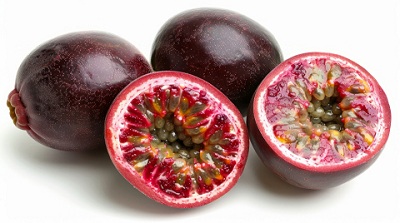
| Category | Information |
|---|---|
| Flower Name | Passion Flower |
| Scientific Name | Passiflora edulis |
| Nutritional Value | Per 100g: Calories – 97, Carbohydrates – 23.4g, Dietary Fiber – 10.4g, Sugars – 11.2g, Protein – 2.2g, Vitamin C – 30mg, Potassium – 348mg, Calcium – 12mg |
| Common Uses | Eaten fresh, in juices, desserts, and salads. |
| Seasonality | Year-round, with peak season in late summer and fall |
| Health Benefits | – High in dietary fiber, promoting digestion and heart health. – Rich in vitamin C, supporting immune function. – Contains antioxidants, supporting overall health. |
| Interesting Fact | Red passion fruit is known for its tart and sweet flavor and is often used in tropical fruit blends and desserts. |
49. Red Fig
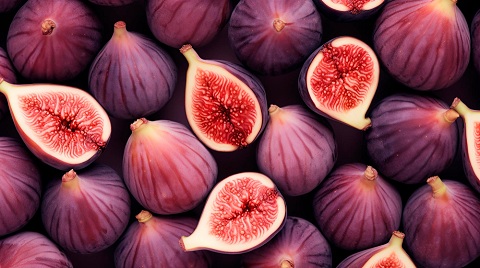
| Category | Information |
|---|---|
| Flower Name | Fig Blossom |
| Scientific Name | Ficus carica |
| Nutritional Value | Per 100g: Calories – 74, Carbohydrates – 19.2g, Dietary Fiber – 2.9g, Sugars – 16.3g, Protein – 0.8g, Vitamin C – 2mg, Potassium – 232mg, Calcium – 35mg |
| Common Uses | Eaten fresh, in salads, desserts, and as a garnish. |
| Seasonality | Late summer to early fall |
| Health Benefits | – High in dietary fiber, promoting digestion and heart health. – Contains antioxidants, supporting overall health. – Provides potassium, supporting blood pressure regulation. |
| Interesting Fact | Red figs are known for their sweet, honey-like flavor and are often used in gourmet dishes and desserts. |
50. Red Prickly Pear
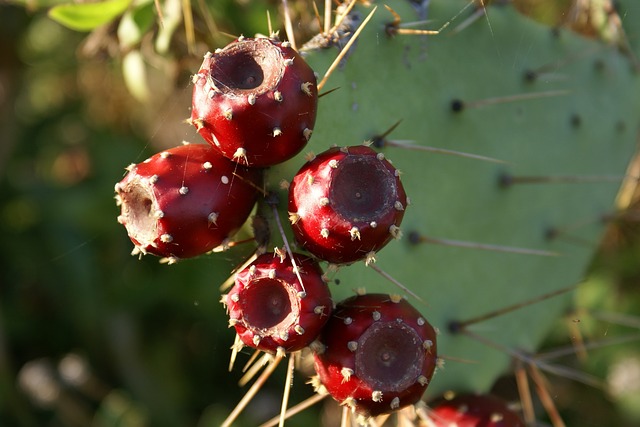
| Category | Information |
|---|---|
| Flower Name | Prickly Pear Blossom |
| Scientific Name | Opuntia ficus-indica |
| Nutritional Value | Per 100g: Calories – 41, Carbohydrates – 9.6g, Dietary Fiber – 3.6g, Sugars – 0.9g, Protein – 0.7g, Vitamin C – 14mg, Potassium – 220mg, Calcium – 56mg |
| Common Uses | Eaten fresh, in salads, juices, and jellies. |
| Seasonality | Late summer to early fall |
| Health Benefits | – High in fiber, aiding digestion and heart health. – Rich in antioxidants, supporting overall health. – Contains vitamin C, boosting immune function. |
| Interesting Fact | Red prickly pear, also known as “tuna” in Spanish, is a fruit from a cactus and is known for its sweet, melon-like flavor and vibrant red color. |
Visited 3 times, 1 visit(s) today
